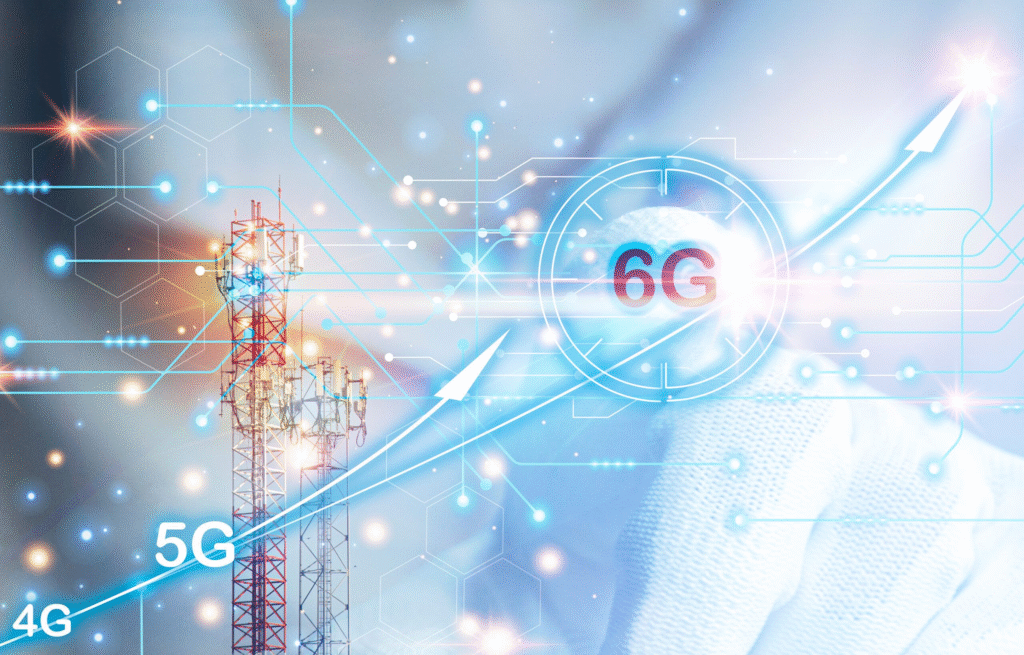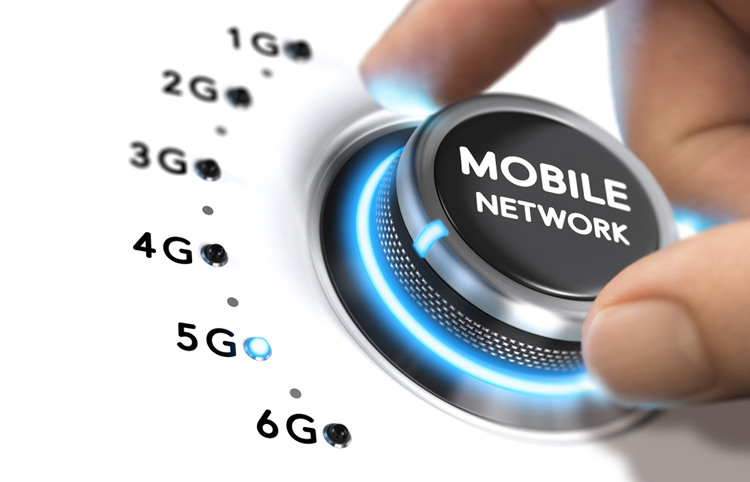5G changed everything, but the next leap—6G—is already taking shape. Discover 8 signs 6G is underway, what makes it different, and how it will reshape everyday life by 2030.
5G marked a major technological milestone—but the story doesn’t end there. Across labs, governments, and global standard bodies, 6G is already being developed, targeting commercialization by 2030. From terahertz networks to AI-driven intelligence, 6G promises to merge digital and physical worlds more seamlessly than ever before.
Why We’re Talking 6G Now
“Wait, isn’t 5G still new?”
That’s the question most people ask—and rightly so. But in the fast-moving telecom world, development for the next generation always begins years in advance.
Right now, the groundwork for 6G is actively being laid. The Global Mobile Suppliers Association (GSA) confirms that dozens of telecom companies and national initiatives are already funding 6G research and pilot programs.
So while 5G continues to mature, the race to 6G has officially begun. This article will answer the burning questions around 6G—how it’s evolving, what makes it different, and how it could transform industries, connectivity, and your everyday life.
1. What Comes After 5G? Understanding the Generational Leap
What Is 6G, in Simple Terms?
6G—or sixth-generation wireless—is the next evolution of mobile network technology, following 5G and 5G-Advanced. Its vision is to deliver ultra-fast, ultra-reliable, AI-driven connectivity that integrates physical, digital, and even biological environments into one cohesive ecosystem.
In simpler terms, if 5G gave us lightning-fast speeds, 6G aims to give us limitless intelligence in real time.
5G vs 6G: The Key Differences
| Feature | 5G | 6G |
|---|---|---|
| Speed | Up to 20 Gbps | Target: Up to 1 Tbps (1000 Gbps) |
| Latency | ~1 ms | Sub-millisecond (0.1 ms goal) |
| Spectrum | Up to millimeter wave | Terahertz (THz) bands |
| Core Intelligence | Software-defined networks | AI-native & self-optimizing |
| Network Role | Communication infrastructure | Sensing + communication hybrid |
| Integration | Mostly terrestrial | Terrestrial + non-terrestrial (satellite, UAV, space) |
The Bridge: 5G-Advanced
Before 6G officially arrives, 5G-Advanced (3GPP Release 18–19) will serve as a transitional generation, introducing AI integration, edge computing, and ultra-reliable low-latency communication (URLLC) enhancements.
Think of it as the “test bed” for technologies that will define 6G.

2. The 8 Strongest Signs That 6G Is Already Underway
Despite public perception that 6G is futuristic, evidence shows that the groundwork is already happening today.
1. Official Standardization Has Begun
The 3rd Generation Partnership Project (3GPP) and International Telecommunication Union (ITU) are already developing frameworks under the IMT-2030 initiative.
Formal technical work has started, defining performance targets, spectrum needs, and baseline architectures. This is not speculation—it’s standardization in motion.
2. Massive Global Investment Is Pouring In
Governments and corporations are heavily funding 6G R&D.
- The U.S. NTIA launched the “Next G Alliance” for 6G research.
- China launched multiple 6G satellites to test THz frequencies.
- The European Union initiated Hexa-X and Hexa-X II, pioneering network intelligence.
- India launched the Bharat 6G Alliance and signed the “Delhi Declaration.”
Market projections suggest 6G technology will surge from $8 billion in 2025 to over $100 billion by 2032.
3. Early Trials and Record-Breaking Experiments
- China achieved 206 Gbps terahertz transmission in lab conditions.
- UAE became the first Middle Eastern nation to test 6G, reaching 145 Gbps.
- Nvidia developed a cloud simulation platform for 6G network research.
4. Roadmaps Target Commercial Rollout by 2030
Nearly every major telecom firm—Ericsson, Nokia, Samsung, Huawei—has aligned around 2030 for first commercial rollouts.
Some even suggest pilot deployments by 2028.
5. 5G-Advanced Is Already Blurring into 6G
Technologies being rolled out in 5G-Advanced—like AI-driven resource management, energy optimization, and network slicing—are all fundamental 6G building blocks.
That means, in many ways, 6G’s DNA is already inside the latest 5G networks.
6. AI-Native Networks Are the Core of 6G
6G won’t just use AI—it will be AI-native.
Instead of human-managed configurations, 6G networks will self-optimize in real-time, using machine learning to adapt to demand, interference, and user behavior.
This marks the beginning of self-evolving networks.
7. Enabling Technologies Are Maturing Fast
Innovations like distributed massive MIMO, intelligent reflective surfaces (IRS), terahertz front-ends, and quantum-level encryption are progressing rapidly.
These advances are critical to delivering ultra-fast, ultra-secure connectivity.
8. Use Cases Are Already Being Mapped Out
Potential 6G applications include:
- Holographic telepresence for immersive calls
- Digital twins for cities and factories
- Real-time remote surgeries
- Swarm robotics for logistics and defense
- Self-healing networks that predict and fix issues automatically
These aren’t just futuristic ideas—they’re part of actual 6G research blueprints.

3. What 6G Could Mean for Everyday Life
It’s one thing to understand the technology—but how does 6G impact you?
For Consumers
Imagine downloading an entire 8K movie in less than a second.
Video calls rendered as 3D holograms.
Smart glasses overlaying live translations, stats, and navigation in real-time.
6G will support a hyperconnected lifestyle, blurring the line between virtual and real.
For Healthcare
6G’s low latency will enable real-time remote surgeries, AI-assisted diagnostics, and wearable biosensors connected to hospital systems.
Doctors could operate robotic instruments from thousands of miles away with zero lag.
For Industry & Manufacturing
Factories will deploy autonomous robots, digital twin simulations, and predictive maintenance systems that communicate in microseconds.
This leads to smarter, safer, and more efficient production.
For Smart Cities
6G could allow cities to monitor traffic, pollution, and energy in real-time.
Infrastructure will self-adjust—traffic lights, EV charging, and public transport coordinated through AI.
For Education
Imagine classrooms where students interact in mixed-reality environments, learning from AI tutors who respond to facial cues and tone in real time.
4. The Real Challenges Ahead
Despite the excitement, 6G faces substantial hurdles.
1. Infrastructure Costs
6G networks require ultra-dense small cells and fiber backhaul. Global infrastructure investments could exceed $1 trillion by 2030.
2. Spectrum Regulation
Allocating terahertz frequencies will demand new international policies. Governments must coordinate tightly to avoid interference and access inequality.
3. Power Consumption & Sustainability
With more data and devices, energy efficiency is critical. AI and smart grids must offset growing power demand.
4. Device Compatibility
5G devices will not support 6G hardware. Expect gradual replacement cycles starting post-2029.
5. Security & Privacy
6G’s integration with IoT and sensors will generate unprecedented volumes of data, heightening privacy concerns and cybersecurity risks.
5. FAQs — Answering the Internet’s Top 10 Questions About 6G
1. Is 6G Real Yet?
Not commercially, but yes, it’s real in development.
Over 20 nations have launched R&D initiatives, and 3GPP’s first study items are under review.
2. When Will 6G Roll Out?
The consensus points to 2030 for commercial release.
Early field tests and pre-standard deployments may appear by 2028–2029.
3. Will 6G Replace 5G?
Not right away. Expect 5G and 6G to coexist for several years, similar to how 4G still supports 5G infrastructure today.
4. How Fast Will 6G Be?
Lab targets reach 1 terabit per second (1 Tbps).
That’s 50× faster than 5G’s top commercial speeds.
5. Which Countries Are Leading 6G Research?
- China (THz satellites, R&D centers)
- United States (Next G Alliance, NTIA projects)
- EU / Finland / Germany (Hexa-X projects)
- Japan & Korea (collaborations with universities)
- India (Bharat 6G Alliance and international partnerships)
6. Will My 5G Phone Work on 6G?
No—new 6G-compatible chips and antennas are required.
However, backward compatibility will allow 6G devices to connect to 5G where necessary.
7. How Will 6G Benefit IoT?
It will empower massive IoT, connecting billions of devices with microsecond latency and minimal energy use. Perfect for smart homes, logistics, and industrial automation.
8. What Are the Biggest Technical Challenges?
- Short signal range at terahertz frequencies
- Heat and energy dissipation
- Massive data handling and privacy
- Need for sustainable network architectures
9. How Will 6G Help Rural America?
Through non-terrestrial networks (NTN)—satellites, high-altitude platforms, and drones—6G aims to eliminate connectivity gaps across rural and remote regions.
10. Should Businesses Prepare for 6G Now?
Yes—but strategically.
Focus on future-ready architecture, AI integration, and modular design that can evolve with new standards.
6. Practical Tips for Businesses and Developers
To prepare your operations or digital strategy for 6G’s arrival:
- Invest in AI and Edge Computing: These will be core to next-gen network operations.
- Follow 3GPP & ITU Updates: Standards evolve fast—staying informed ensures compliance.
- Design Modular IoT Systems: Build devices that can adapt to future spectrum and bandwidth shifts.
- Plan for Security: Adopt zero-trust frameworks and data encryption by default.
- Educate Your Teams: Encourage cross-skilling in machine learning, cloud orchestration, and RF engineering.
8. Final Thoughts: The Dawn of the 6G Era
We often underestimate how quickly new generations of technology arrive.
Just a decade ago, 4G was revolutionary. Then came 5G, which redefined mobile computing.
Now, 6G promises something even bigger—a fusion of intelligence, connectivity, and sensing that will enable smart cities, immersive experiences, and intelligent machines to thrive together.
While full-scale deployment may be a few years away, the revolution has already started.
Governments are strategizing, researchers are testing terahertz chips, and AI-driven networks are forming the backbone of what’s next.

